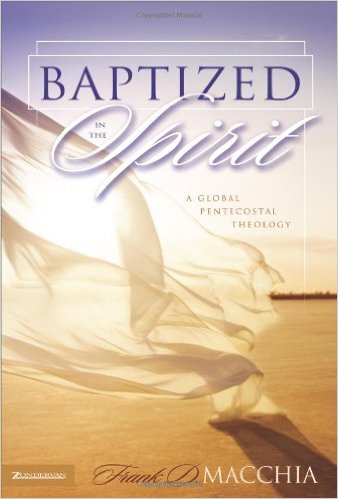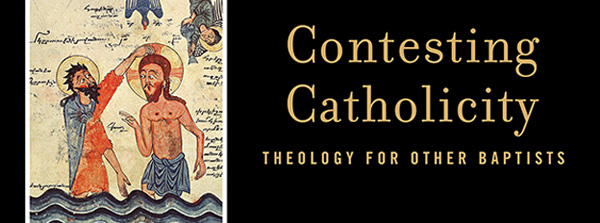 Having outlined his approach to ecclesiology, Macchia continues his discussion by considering three classic biblical metaphors for the church in their relation to Spirit-baptism: the church as the people of God, the body of Christ, and the temple of the Holy Spirit. The Baptism with the Holy Spirit serves to distinguish the old and the new people of God, forms the church as the body (and bride) of Christ, and continually adds new members to it. The Spirit-filled body and temple is a missional entity, testifying in the world to an alternate—eschatological—reality.
Having outlined his approach to ecclesiology, Macchia continues his discussion by considering three classic biblical metaphors for the church in their relation to Spirit-baptism: the church as the people of God, the body of Christ, and the temple of the Holy Spirit. The Baptism with the Holy Spirit serves to distinguish the old and the new people of God, forms the church as the body (and bride) of Christ, and continually adds new members to it. The Spirit-filled body and temple is a missional entity, testifying in the world to an alternate—eschatological—reality.
The Spirit-filled temple reaches in priestly ministry and prophetic witness for the four corners of the earth in order to foreshadow the coming new creation as the final dwelling place of God. … The church as the temple of the Spirit becomes the harbinger of the sanctification of creation into the very image of Christ as God’s dwelling place to the glory of God (204).
Turning from the classic metaphors to the creedal marks of the church, Macchia identifies a variety of ‘marks’ which have been used by various groups in Christian history to describe the nature and activity of the church. He suggests that all these various marks are mutually supporting and informing lenses through which the classical marks—the church as “one, holy, catholic, and apostolic”—have continuing relevance. Macchia views the marks as describing the eschatological people of God, and therefore as a vision to be pursued and embodied by the church in the present, in discipleship, service, and witness.
The classic marks are not replaced by these other ‘marks’ but are qualified and read through these others as lenses. The marks as eschatological gifts of the Spirit bestowed by Christ are also goals in which we are constantly to be renewed and toward which we strive (209).
Understanding the marks in the light of Spirit-baptism provides interesting insight into the nature of the church. The unity of the church is not uniformity or the formation of one “world-church,” but communion in the midst of an increasingly diversifying plurality of Christian experience and expression, though within a common confession. The tongues of Pentecost bear witness to this dynamism, so that “the unity of Pentecost is thus not abstract and absolute but rather concrete and pluralistic” (218). This is a unity that “respects and fulfills the scattering and diversification of peoples from Babel. Otherness is not denied but embraced in this differentiated and complex unity of the church at Pentecost” (218). Thus the church embraces the tensions of diversity, respecting others and avoiding uniformity or conformity.
The holiness of the church is secured by the Holy Spirit who mightily indwells it as the presence of a holy God who transforms his people. The church is sanctified through the gospel, its members through their incorporation into the holy community, and by being set apart for a holy task. They are continually being transformed as they live in accordance with Word, Spirit and the community.
Macchia understands catholicity in terms of “fullness” rather than universality, and discusses the term in a sense analogous to his discussion of unity. The Spirit blesses the church with a rich variety of spiritual, historical, denominational, and cultural gifts, no one group or church being the true fullness all on its own. Here Macchia also discusses the ecumenical challenge, as well as what he calls the “Catholic claim.”
We cannot discuss catholicity in avoidance of this Catholic claim. It must be taken seriously. We must ask whether or not we are guilty of gazing so intently on the pneumatological constitution and eschatological fulfillment of catholicity in the new creation that we are blind to the christological institution of the church and its historic continuity as the visible body of the faithful. I believe that Küng is right that there is historical validity to the “mother church” idea. The Roman Catholic Church has a certain “parental” role in the family tree of the Christian church in the world (227).
He continues, however:
Suffice it to say here that the “mother” Catholic Church belongs herself to a heritage in the outpouring of the Spirit to which she is as accountable as any of us and on which she can, in my view, lay no privileged claim. We as her children and grandchildren respect her role in history in passing on to us a precious heritage in the form of witness. But our reception of this witness draws us to the same source from which she has received it and must continue to receive it. There are thus limits to how far one can stretch the metaphor of her maternal role in relation to us (228, original emphasis).
A Spirit-baptized view of apostolicity understands it in terms of leadership and mission. Apostolic succession is a characteristic of the whole church and not simply one office in it. “If Pentecostalism is anything,” says Macchia, “it is ‘apostolic’ by intention. Its original mission was dedicated to the ‘apostolic faith,’ and many Pentecostal churches around the world since then have raised the banner of ‘apostolic’ quite high” (229). The whole church shares the original faith, experience and mission of the earliest apostles and the churches they founded (230). Just as the Spirit led and gifted the original churches, so the Spirit continues to supply the church with guidance and gifts for its contemporary mission.
Macchia concludes his ecclesiological reflections with consideration of the sacraments, and “marks” more specifically associated with the Pentecostal churches—charismatic fullness and preaching. Sacraments and spiritual gifts are means by which the Spirit’s gracious presence is mediated to and experienced in the church and the world. Water baptism can only be understood in relation to Spirit-baptism: the two are inseparable, even if in one’s experience, one is not conscious of this relation (249). Macchia thus maintains the unity of Spirit and water baptism, while still allowing space for distinction between the two in terms of one’s experience. So, too, the heart of the sacramental meal is the epiclesis in which the Spirit’s presence and work in invoked. Too often, however, the liturgy “does not linger over this. It does not wait for this to happen” (253). Macchia therefore argues for a more interactive liturgy whereby participants are encouraged to “open up to deeper experiences of divine infilling than they might be prone to have if sitting in isolation on a pew” (254).
We should shift the focus from the transformation of the elements to Christ’s participation by the Spirit in the communal act and our communion with him and one another by means of the same Spirit (255).
 I picked up one new book at the ANZATS Conference this year, which is something of a record (to buy only one…)! The book by Curtis Freeman is entitled, Contesting Catholicity: Theology for Other Baptists. Freeman is Research Professor of Theology and Director of the Baptist House of Studies at Duke Divinity School. The term “other Baptists” comes from a list of Baptist statistics, in which various Baptist denominations were named. The final category in the statistical list was “Other Baptist.” As he reflected on the list, he realised that he belonged to that category of “Other Baptists,” which he defines as neither conservative nor liberal. Here is a paragraph from the Preface of the volume:
I picked up one new book at the ANZATS Conference this year, which is something of a record (to buy only one…)! The book by Curtis Freeman is entitled, Contesting Catholicity: Theology for Other Baptists. Freeman is Research Professor of Theology and Director of the Baptist House of Studies at Duke Divinity School. The term “other Baptists” comes from a list of Baptist statistics, in which various Baptist denominations were named. The final category in the statistical list was “Other Baptist.” As he reflected on the list, he realised that he belonged to that category of “Other Baptists,” which he defines as neither conservative nor liberal. Here is a paragraph from the Preface of the volume: